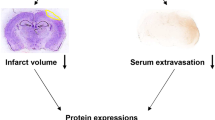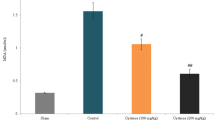Abstract
It has been suggested that oxidative stress plays an important role in the pathophysiology of traumatic brain injury (TBI). N-acetylcysteine (NAC) and selenium (Se) display neuroprotective activities mediated at least in part by their antioxidant and anti-inflammatory properties although there is no report on oxidative stress, antioxidant vitamin, interleukin-1 beta (IL)-1β and IL-4 levels in brain and blood of TBI-induced rats. We investigated effects of NAC and Se administration on physical injury-induced brain toxicity in rats. Thirty-six male Sprague–Dawley rats were equally divided into four groups. First and second groups were used as control and TBI groups, respectively. NAC and Se were administrated to rats constituting third and forth groups at 1, 24, 48 and 72 h after TBI induction, respectively. At the end of 72 h, plasma, erythrocytes and brain cortex samples were taken. TBI resulted in significant increase in brain cortex, erythrocytes and plasma lipid peroxidation, total oxidant status (TOS) in brain cortex, and plasma IL-1β values although brain cortex vitamin A, β-carotene, vitamin C, vitamin E, reduced glutathione (GSH) and total antioxidant status (TAS) values, and plasma vitamin E concentrations, plasma IL-4 level and brain cortex and erythrocyte glutathione peroxidase (GSH-Px) activities decreased by TBI. The lipid peroxidation and IL-1β values were decreased by NAC and Se treatments. Plasma IL-4, brain cortex GSH, TAS, vitamin C and vitamin E values were increased by NAC and Se treatments although the brain cortex vitamin A and erythrocyte GSH-Px values were increased through NAC only. In conclusion, NAC and Se caused protective effects on the TBI-induced oxidative brain injury and interleukin production by inhibiting free radical production, regulation of cytokine-dependent processes and supporting antioxidant redox system.


Similar content being viewed by others
Abbreviations
- GSH:
-
Glutathione
- GSH-Px:
-
Glutathione peroxidase
- LP:
-
Lipid peroxidation
- MDA:
-
Malondialdehyde
- ROS:
-
Reactive oxygen species
- SOD:
-
Superoxide dismutase
- TAS:
-
Total antioxidant status
- TOS:
-
Total oxidant status
References
Halliwell B (2006) Oxidative stress and neurodegeneration: where are we now? J Neurochem 97:1634–1658
Nazıroğlu M (2007) New molecular mechanisms on the activation of TRPM2 channels by oxidative stress and ADP-ribose. Neurochem Res 32:1990–2001
Nazıroğlu M, Yürekli VA (2013) Effects of antiepileptic drugs on antioxidant and oxidant molecular pathways: focus on trace elements. Cell Mol Neurobiol 33:589–599
Mustafa AG, Singh IN, Wang J, Carrico KM, Hall ED (2010) Mitochondrial protection after traumatic brain injury by scavenging lipid peroxyl radicals. J Neurochem 114:271–280
Khan M, Sakakima H, Dhammu TS, Shunmugavel A, Im YB, Gilg AG, Singh AK, Singh I (2011) S-nitrosoglutathione reduces oxidative injury and promotes mechanisms of neurorepair following traumatic brain injury in rats. J Neuroinflamm 8:78
Nazıroğlu M, Yıldız K, Tamtürk B, Erturan İ, Flores-Arce M (2012) Selenium and psoriasis. Biol Trace Elem Res 150:3–9
Nazıroğlu M (2012) Molecular role of catalase on oxidative stress-induced Ca(2+) signaling and TRP cation channel activation in nervous system. J Recept Signal Transduct Res 32:134–141
Nazıroğlu M (2009) Role of selenium on calcium signaling and oxidative stress-induced molecular pathways in epilepsy. Neurochem Res 34:2181–2191
Özgül C, Nazıroğlu M (2012) TRPM2 channel protective properties of N-acetylcysteine on cytosolic glutathione depletion dependent oxidative stress and Ca2+ influx in rat dorsal root ganglion. Physiol Behav 106:122–128
Joshi YB, Praticò D (2012) Vitamin E in aging, dementia, and Alzheimer’s disease. BioFactors 38:90–97
Lee HP, Casadesus G, Zhu X, Lee HG, Perry G, Smith MA, Gustaw-Rothenberg K, Lerner A (2009) All-trans retinoic acid as a novel therapeutic strategy for Alzheimer’s disease. Expert Rev Neurother 9:1615–1621
Bains M, Hall ED (2012) Antioxidant therapies in traumatic brain and spinal cord injury. Biochim Biophys Acta 1822:675–684
Özmen I, Naziroğlu M, Alici HA, Sahin F, Cengiz M, Eren I (2007) Spinal morphine administration reduces the fatty acid contents in spinal cord and brain by increasing oxidative stress. Neurochem Res 32:19–25
Moore M (2013) Mild traumatic brain injury: implications for social work research and practice with civilian and military populations. Soc Work Health Care 52:498–518
Freire MA (2012) Pathophysiology of neurodegeneration following traumatic brain injury. West Indian Med J 61:751–755
Xiong Y, Shie FS, Zhang J, Lee CP, Ho YS (2004) The protective role of cellular glutathione peroxidase against trauma-induced mitochondrial dysfunction in the mouse brain. J Stroke Cerebrovasc Dis 13:129–137
Fang KM, Cheng FC, Huang YL, Chung SY, Jian ZY, Lin MC (2013) Trace element, antioxidant activity, and lipid peroxidation levels in brain cortex of gerbils after cerebral ischemic injury. Biol Trace Elem Res 152:66–74
Marmarou A, Foda MA, van den Brink W, Campbell J, Kita H, Demetriadou K (1994) A new model of diffuse brain injury in rats. Part I: pathophysiology and biomechanics. J Neurosurg 80:291–300
Oksay T, Nazıroğlu M, Ergün O, Doğan S, Özatik O, Armağan A, Özorak A, Çelik Ö (2013) N-acetylcysteine attenuates diazinon exposure-induced oxidative stress in rat testis. Andrologia 45:171–177
Nazıroğlu M, Kutluhan S, Yilmaz M (2008) Selenium and topiramate modulates brain microsomal oxidative stress values, Ca2+-ATPase activity, and EEG records in pentylentetrazol-induced seizures in rats. J Membr Biol 225:39–49
Placer ZA, Cushman L, Johnson BC (1966) Estimation of products of lipid peroxidation (malonyl dialdehyde) in biological fluids. Anal Biochem 16:359–364
Sedlak J, Lindsay RH (1968) Estimation of total, protein-bound, and nonprotein sulfhydryl groups in tissue with Ellman’s reagent. Anal Biochem 25:192–205
Nazıroğlu M, Karaoğlu A, Aksoy AO (2004) Selenium and high dose vitamin E administration protects cisplatin-induced oxidative damage to renal, liver and lens tissues in rats. Toxicology 195:221–230
Calışkan AM, Naziroğlu M, Uğuz AC, Ovey IS, Sütçü R, Bal R, Calişkan S, Ozcankaya R (2010) Acamprosate modulates alcohol-induced hippocampal NMDA receptors and brain microsomal Ca2+-ATPase but induces oxidative stress in rat. J Membr Biol 237:51–58
Lawrence RA, Burk RF (1976) Glutathione peroxidase activity in selenium-deficient rat liver. Biochem Biophys Res Commun 71:952–958
Lowry OH, Rosebrough NJ, Farr AL et al (1951) Protein measurement with the folin phenol reagent. J Biol Chem 193:265–275
Desai ID (1984) Vitamin E analysis methods for animal tissues. Methods Enzymol 105:138–147
Suzuki J, Katoh N (1990) A simple and cheap method for measuring vitamin A in cattle using only a spectrophotometer. Jpn J Vet Sci 52:1282–1284
Jagota SK, Dani HM (1982) A new colorimetric technique for the estimation of vitamin C using Folin phenol reagent. Anal Biochem 127:178–182
Erel O (2004) A novel automated direct measurement method for total antioxidant capacity using a new generation, more stable ABTS radical cation. Clin Biochem 37:277–285
Paredes SD, Bejarano I, Terrón MP, Barriga C, Reiter RJ, Rodríguez AB (2009) Melatonin and tryptophan counteract lipid peroxidation and modulate superoxide dismutase activity in ringdove heterophils in vivo. Effect of antigen-induced activation and age. Age (Dordr) 31:179–188
Nazıroğlu M (2011) TRPM2 cation channels, oxidative stress and neurological diseases: where are we now? Neurochem Res 36:355–366
Nazıroğlu M, Dikici DM, Dursun S (2012) Role of oxidative stress and Ca(2+) signaling on molecular pathways of neuropathic pain in diabetes: focus on TRP channels. Neurochem Res 37:2065–2075
Yeo JE, Kang SK (2007) Selenium effectively inhibits ROS-mediated apoptotic neural precursor cell death in vitro and in vivo in traumatic brain injury. Biochim Biophys Acta 1772:1199–1210
Yeo JE, Kim JH, Kang SK (2008) Selenium attenuates ROS-mediated apoptotic cell death of injured spinal cord through prevention of mitochondria dysfunction; in vitro and in vivo study. Cell Physiol Biochem 21:225–238
Cimen MY (2008) Free radical metabolism in human erythrocytes. Clin Chim Acta 390:1–11
Nazıroğlu M, Ciğ B, Ozgül C (2013) Neuroprotection induced by N-acetylcysteine against cytosolic glutathione depletion-induced Ca2+ influx in dorsal root ganglion neurons of mice: role of TRPV1 channels. Neuroscience 242:151–160
Xiong Y, Peterson PL, Lee CP (1999) Effect of N-acetylcysteine on mitochondrial function following traumatic brain injury in rats. J Neurotrauma 16:1067–1082
Woodcock T, Morganti-Kossmann MC (2013) The role of markers of inflammation in traumatic brain injury. Front Neurol 4:18
Utagawa A, Truettner JS, Dietrich WD, Bramlett HM (2008) Systemic inflammation exacerbates behavioral and histopathological consequences of isolated traumatic brain injury in rats. Exp Neurol 211:283–291
Jones NC, Prior MJ, Burden-Teh E, Marsden CA, Morris PG, Murphy S (2005) Antagonism of the interleukin-1 receptor following traumatic brain injury in the mouse reduces the number of nitric oxide synthase-2-positive cells and improves anatomical and functional outcomes. Eur J Neurosci 22:72–78
Clausen F, Hånell A, Israelsson C, Hedin J, Ebendal T, Mir AK, Gram H, Marklund N (2011) Neutralization of interleukin-1β reduces cerebral edema and tissue loss and improves late cognitive outcome following traumatic brain injury in mice. Eur J Neurosci 34:110–123
Lijia Z, Zhao S, Wang X, Wu C, Yang J (2012) A self-propelling cycle mediated by reactive oxide species and nitric oxide exists in LPS-activated microglia. Neurochem Int 61:1220–1230
Haber M, Abdel Baki SG, Grin’kina NM, Irizarry R, Ershova A, Orsi S, Grill RJ, Dash P, Bergold PJ (2013) Minocycline plus N-acetylcysteine synergize to modulate inflammation and prevent cognitive and memory deficits in a rat model of mild traumatic brain injury. Exp Neurol 249:169–177
Marini H, Altavilla D, Bellomo M, Adamo EB, Marini R, Laureanti F, Bonaccorso MC, Seminara P, Passaniti M, Minutoli L, Bitto A, Calapai G, Squadrito F (2004) Modulation of IL-1 beta gene expression by lipid peroxidation inhibition after kainic acid-induced rat brain injury. Exp Neurol 188:178–186
Acknowledgments
M.N. and N.Ş. formulated the present hypothesis and was responsible for writing the report. N.Ş. and V.Y. were responsible for the induction of TBI. M.N. was responsible for the analyses. All authors approved the final manuscript. Chemical expenses of the current study were supported by N.Ş. The study was performed in Neuroscience Research Center, Suleyman Demirel University, Isparta, Turkey.
Conflict of interest
The authors declare that they have no conflict of interest.
Author information
Authors and Affiliations
Corresponding author
Rights and permissions
About this article
Cite this article
Şenol, N., Nazıroğlu, M. & Yürüker, V. N-Acetylcysteine and Selenium Modulate Oxidative Stress, Antioxidant Vitamin and Cytokine Values in Traumatic Brain Injury-Induced Rats. Neurochem Res 39, 685–692 (2014). https://doi.org/10.1007/s11064-014-1255-9
Received:
Revised:
Accepted:
Published:
Issue Date:
DOI: https://doi.org/10.1007/s11064-014-1255-9




